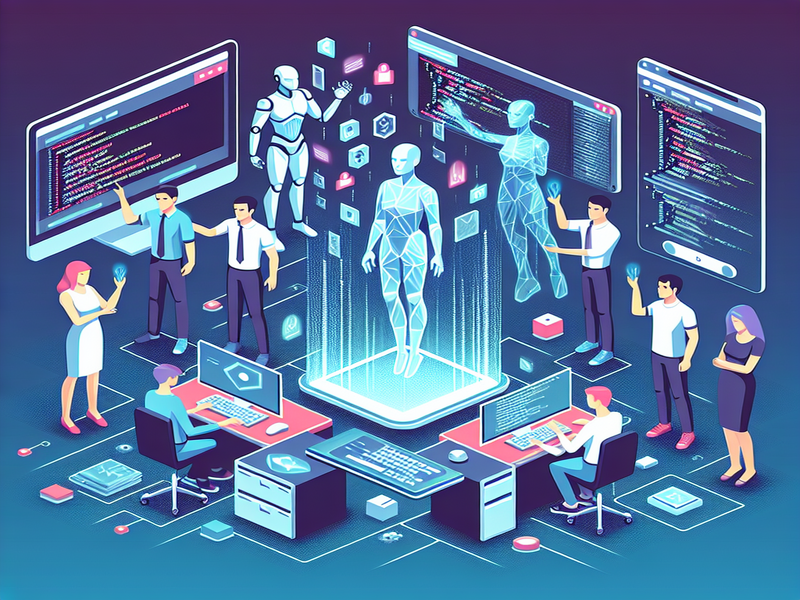- Updated: August 3, 2024
- 5 min read
Software 3.0: The Era of Intelligent Software Development
Introduction to Software 3.0
The world of software development is on the cusp of a seismic shift, ushering in a new era of intelligent and autonomous programming. Welcome to Software 3.0, a paradigm that promises to revolutionize the way we create and interact with software. In this new realm, artificial intelligence (AI) agents take center stage, generating code and neural networks tailored to specific instructions and datasets, empowering businesses and individuals alike to harness the full potential of intelligent software development.
The Evolution: From Software 1.0 to Software 3.0
To fully grasp the significance of Software 3.0, it’s essential to understand the journey that brought us here. Software 1.0, the classical stack, is what we’re all familiar with – code written by programmers in languages like Python, C++, and JavaScript, following explicit instructions to compilers and interpreters. This approach has served us well, but it has limitations in terms of scalability and adaptability.
Software 2.0 emerged as a game-changer, introducing neural networks and machine learning models into the equation. Instead of writing every line of code, programmers curated and cleansed datasets, trained neural networks, and integrated them into applications. This shift allowed for more abstract and complex behaviors to be encoded, but it also introduced new challenges, such as the difficulty in interpreting and explaining the decision-making process of these models.
Enter Software 3.0, a synthesis of the best aspects of its predecessors. In this paradigm, programmers provide a set of instructions and a dataset that define the desired behavior of the software. An AI agent then takes these inputs and generates the program, including both programmer-readable code and trained neural network models. This process effectively combines the interpretability and adaptability of traditional code with the powerful pattern recognition and decision-making capabilities of machine learning models.

Benefits of Software 3.0
The advent of Software 3.0 promises to unlock a multitude of benefits for businesses and developers alike:
- Expanded Program Space: Software 3.0 can produce outputs encompassing both traditional code and neural network models, effectively expanding the range of possible behaviors and applications.
- Improved Explainability and Interpretability: By generating programmer-readable code, Software 3.0 enhances the transparency and interpretability of software systems, making it easier to understand and modify their behavior.
- Increased Adaptability: With the ability to modify code directly, Software 3.0 applications can be more easily adapted and updated to meet changing requirements or address emerging issues.
- Democratization of Programming: By allowing natural language instructions to guide the development process, Software 3.0 has the potential to lower the barriers to entry for programming, enabling more people to contribute to software development.
- Accelerated Development Velocity: Automation of both deterministic and statistical aspects of software development can significantly increase the speed at which applications can be built and deployed.
Limitations and Challenges
While the potential of Software 3.0 is undeniable, it is not without its challenges and limitations. One of the primary concerns is the potential for AI-generated code to contain bugs or inefficiencies, which could be overlooked or difficult to identify and fix. Additionally, the statistical nature of the models used in Software 3.0 means that they may exhibit unintuitive or unexpected behaviors, potentially leading to silent failures or the adoption of undesirable biases.
Another challenge lies in ensuring the responsible and ethical development of Software 3.0 systems. As these systems become more powerful and capable of generating complex software, it will be crucial to implement robust safeguards and guidelines to prevent misuse or unintended consequences.
Future Implications and Predictions
As Software 3.0 continues to evolve and mature, its impact on businesses and society is expected to be profound. One area that is likely to benefit significantly is web design and development. With Software 3.0, product managers and designers could make meaningful changes or suggestions using a simple graphical user interface, and an AI agent would automatically generate the corresponding code updates for review and deployment.
No-code platforms are also poised to become more flexible and powerful, enabling non-technical users to create sophisticated applications by providing natural language instructions and data. Additionally, marketing and customer engagement are likely to be transformed, with AI agents generating personalized content, chatbots, and interactive experiences tailored to individual preferences and behaviors.
Beyond business applications, Software 3.0 could also have a significant impact on research and education. Intelligent agents could assist researchers by automating literature reviews, data gathering, and even hypothesis generation, accelerating the pace of scientific discovery. In the realm of education, adaptive learning systems and personalized tutoring could become more accessible and effective, helping to bridge the gap between learners and educators.
Conclusion
Software 3.0 represents a paradigm shift in the way we approach software development, one that promises to unlock new levels of intelligence, efficiency, and accessibility. By harnessing the power of AI agents and leveraging the strengths of both traditional code and machine learning models, businesses and developers can create software that is more adaptable, interpretable, and tailored to their specific needs.
While challenges and limitations remain, the potential benefits of Software 3.0 are too significant to ignore. As this technology continues to evolve, it will be essential for businesses to stay ahead of the curve, embracing the opportunities presented by intelligent software development while also prioritizing responsible and ethical practices.
The future of software development is here, and it is intelligent, autonomous, and poised to reshape the way we interact with technology. Embrace the power of Software 3.0, and unlock a world of possibilities.
 From vibe coding to vibe deployment. UBOS MCP turns ideas into infra with one message.
From vibe coding to vibe deployment. UBOS MCP turns ideas into infra with one message. 